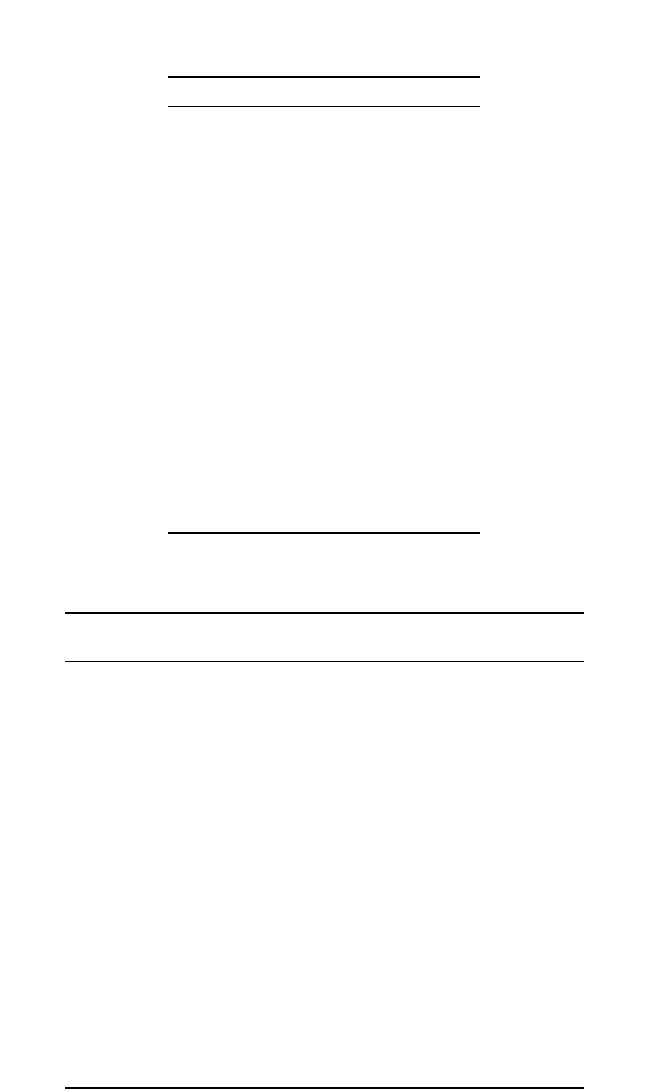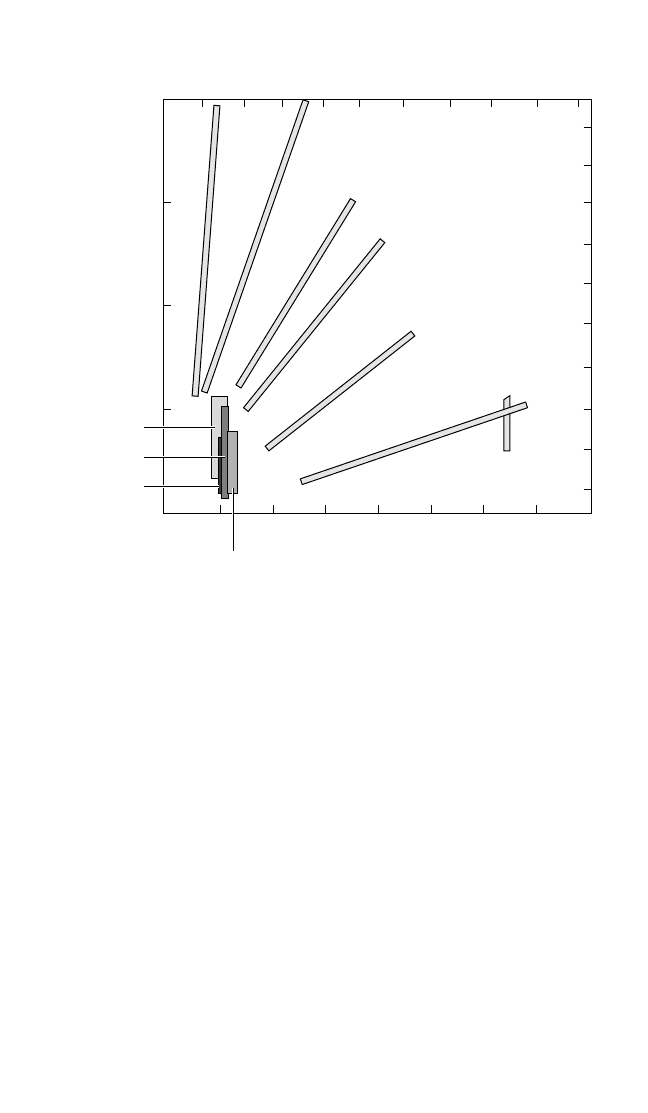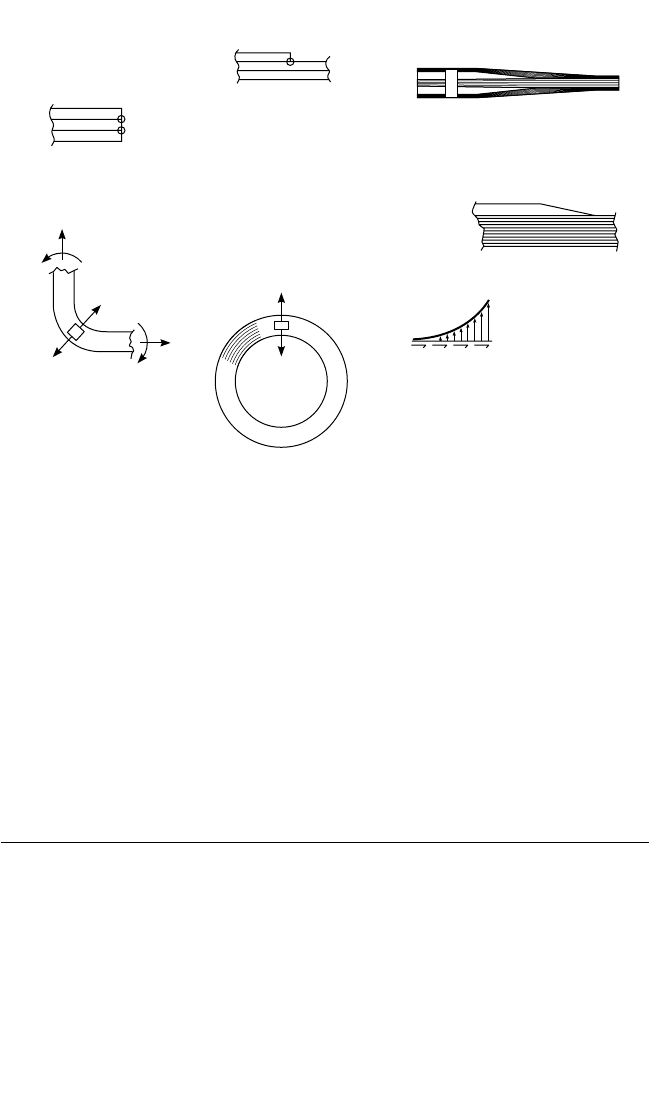Harris C.M., Piersol A.G. Harris Shock and vibration handbook
Подождите немного. Документ загружается.


34.20 CHAPTER THIRTY-FOUR
TABLE 34.9 Stress Values for Fig. 34.9
Peak/trough no. Stress, MPa
193
218
355
410
585
610
737
818
937
10 10
11 46
12 6
13 55
14 46
15 74
16 8
17 55
18 18
19 65
20 39
21 83
22 0
TABLE 34.10 Rainflow Counting
To horizontal distance of Half cycle,
From peak or trough no. point no. MPa
12293
2337
3237
4575
5675
61136
71027
8919
9819
10 9 27
11 10 36
12 21 77
13 14 9
14 13 9
15 16 66
16 15 66
17 18 37
18 17 37
19 20 26
20 19 26
21 12 77
22 1 93
8434_Harris_34_b.qxd 09/20/2001 12:30 PM Page 34.20

The reservoir method employs an analogy of water contained in reservoirs
formed by peaks draining successively out of the troughs. The lowest trough is
drained first, followed by successively higher troughs until the reservoir is empty.
Figure 34.9D demonstrates the reservoir method, and the corresponding values for
the stress range are presented in Table 34.11.
Rainflow counting and reservoir counting give identical results provided that
rainflow counting begins with the highest peak in the loading event, as is shown in
Fig. 34.9. Rainflow counting is more suited to computer analyses or long stress his-
tories, whereas the reservoir method is most convenient for graphical analyses of
short histories.
Table 34.12 presents the results of an analysis according to the Miner linear dam-
age rule assuming 1 million loading sequences of the stress history of Fig. 34.9. The
cyclic fatigue lives presented in the second column are taken from a typical S-N curve
for a beam in which manually welded longitudinal fillet welds are used to connect the
flanges to the web. The analysis indicates that the fatigue evaluation has failed.
ENGINEERING PROPERTIES OF METALS 34.21
TABLE 34.11 Reservoir Counting Method
Drain from trough no. Water level at peak Stress range, MPa
22 1 93
12 21 77
4575
16 15 66
2337
18 17 37
10 11 36
6727
20 19 26
8919
14 13 9
TABLE 34.12 Cumulative Damage Using Miner’s Rule
Stress range, Fatigue resistance, Damage due to 1 × 10
6
loading
∆σ,MPa N = (100/∆σ)
3
,2 × 10
6
cycles events, n
i
/N
93 2,490,000 0.402
77 4,381,000 0.228
75 4,741,000 0.211
66 6,957,000 0.144
37 (twice) 39,480,000 0.051
36 42,870,000 0.023
27 101,600,000 0.010
26 113,800,000 0.009
19 292,600,000 0.003
9 2.7 × 10
9
0.000
Damage summation: Σn
i
/N = 1.08 ≥ 1.0
8434_Harris_34_b.qxd 09/20/2001 12:30 PM Page 34.21

The cyclic fatigue lives in Table 34.12 do not reflect the existence of an endurance
limit or constant-amplitude fatigue limit. Because the Miner rule does not account
for the effect of load sequence, some designers choose to extend the finite life region
of the S-N curve and assume that all cyclic variations contribute to damage accumu-
lation. The opposite extreme would be to neglect all cyclic variations smaller than
the constant-amplitude fatigue limit. A third variation of the procedure employed
by some designers assumes a change in the slope of the experimentally determined
S-N curve at some large number of cycles. For example, between 5 × 10
6
cycles and
10
8
cycles the slope of the S-N curve might be reduced, and the constant-amplitude
fatigue limit might be assumed to occur at 10
8
cycles. In view of the lack of test data
at very long fatigue lives, there is no agreement on which of the three procedures is
most appropriate.
REFERENCES
1. Obtainable from the American Society for Testing and Materials, 1916 Race Street,
Philadelphia, PA 19103.
2. Vallance, A., and V. Doughtie: “Design of Machine Members,” 3d ed., chap. II, McGraw-
Hill Book Company, Inc., New York, 1951.
3. Hoyt, S. I.: “Metal Data,” 2d ed., Reinhold Publishing Corporation, New York, 1952.
4. American Society for Metals:“Metals Handbook,” Vol. 1, “Properties and Selection: Irons,
Steels, and High-Performance Alloys,” 1990.
5. Clark, D. S., and D. S. Wood: Trans. ASM, 42:45, 1950.
6. Manjoine, M. J.: J. Appl. Mechanics, 66:A215, 1944.
7. MacGregor, C. W., and J. C. Fisher: J. Appl. Mechanics, 67:A217, 1945.
8. Lessells, J. M.:“Strength and Resistance of Metals,” p. 7, John Wiley & Sons, Inc., New York,
1954.
9. Battelle Memorial Institute:“Prevention of Failure of Metals under Repeated Stress,” John
Wiley & Sons, Inc., New York, 1946.
10. Bannantine, J. A., J. J. Comer, and J. L. Handrock: “Fundamentals of Metal Fatigue Analy-
sis,” Prentice-Hall, Inc., Englewood Cliffs, N.J., 1990.
11. Barsom, J. M., and S. T. Rolfe: “Fracture and Fatigue Control in Structures,” 2d ed.,
Prentice-Hall, Inc., Englewood Cliffs, N.J., 1987.
12. American Institute of Steel Construction: “Specification for Structural Steel Buildings—
Allowable Stress Design and Plastic Design,” 1989.
13. American Railway Engineering Association: “Specifications for Steel Railway Bridges,”
1994.
14. American Association of State Highway and Transportation Officials: “Standard Specifi-
cations for Highway Bridges,” 1992.
15. American Welding Society: “Structural Welding Code,” D1.1, 1994.
16. Gaylord, E. H., Jr., C. N. Gaylord, and J. E. Stallmeyer: “Structural Engineering Hand-
book,” 4th ed., The McGraw-Hill Companies, Inc., New York, 1996.
17. Miner, M. A.: J.Appl. Mech., 12:A159 (1945).
18. Gurney, T. R.: “Fatigue of Welded Structures,” 2d ed., Cambridge University Press, 1979.
19. Kulak, G. L., and I. F. C. Smith: “Analysis and Design of Fabricated Steel Structures for
Fatigue: A Primer for Civil Engineers,” Structural Engineering Report No. 190, University
of Alberta, Edmonton, Canada, 1993.
34.22 CHAPTER THIRTY-FOUR
8434_Harris_34_b.qxd 09/20/2001 12:30 PM Page 34.22

CHAPTER 35
ENGINEERING PROPERTIES
OF COMPOSITES
Keith T. Kedward
INTRODUCTION
Composite materials are simply a combination of two or more different materials
that may provide superior and unique mechanical and physical properties.The most
attractive composite systems effectively combine the most desirable properties of
their constituents and simultaneously suppress the least desirable properties. For
example, a glass-fiber reinforced plastic combines the high strength of thin glass
fibers with the ductility and environmental resistance of an epoxy resin; the inherent
damage susceptibility of the fiber surface is thereby suppressed whereas the low
stiffness and strength of the resin is enhanced.
The opportunity to develop superior products for aerospace, automotive, and
recreational applications has sustained the interest in advanced composites. Currently
composites are being considered on a broader basis, specifically, for applications that
include civil engineering structures such as bridges and freeway pillar reinforcement,
and for biomedical products such as prosthetic devices. The recent trend toward
affordable composite structures with a somewhat decreased emphasis on performance
will have a major impact on the wider exploitation of composites in engineering.
BASIC TYPES OF COMPOSITES
Composites typically comprise a high-strength synthetic fiber embedded within a
protective matrix. The most mature and widely used composite systems are polymer
matrix composites (PMCs), which will provide the major focus for this chapter. Con-
temporary PMCs typically use a ceramic type of reinforcing fiber such as carbon,
Kevlar, or glass in a resin matrix wherein the fibers make up approximately 60 per-
cent of the PMC volume. Metal or ceramic matrices can be substituted for the resin
matrix to provide a higher-temperature capability. These specialized systems are
termed metal matrix composites (MMCs) and ceramic matrix composites (CMCs); a
35.1
8434_Harris_35_b.qxd 09/20/2001 12:29 PM Page 35.1

general qualitative comparison of the relative merits of all three categories is sum-
marized in Table 35.1.
SHORT FIBER/PARTICULATE COMPOSITES
The fibrous reinforcing constituent of composites may consist of thin continuous
fibers or relatively short fiber segments, or whiskers. However, reinforcing effective-
ness is realized by using segments of relatively high aspect ratio, which is defined as
the length-to-diameter ratio. Nevertheless, as a reinforcement for PMCs, these short
fiber or whisker systems are structurally less efficient and very susceptible to dam-
age from long-term and/or cyclic loading. On the other hand, the substantially lower
cost and reduced anisotropy on the macroscopic scale render these composite sys-
tems appropriate in structurally less demanding industrial applications.
Randomly oriented short fiber or particulate-reinforced composites tend to
exhibit a much higher dependence on polymer-based matrix properties, as com-
pared to typical continuous fiber reinforced PMCs. Elastic modulus, strength, creep,
and fatigue are most susceptible to the significant limitations of the polymer matrix
constituent and fiber-matrix interface properties.
1
CONTINUOUS FIBER COMPOSITES
Continuous fiber reinforcements are generally required for structural or high-
performance applications. The specific strength (strength-to-density ratio) and spe-
cific stiffness (elastic modulus-to-density ratio) of continuous fiber reinforced PMCs,
for example, can be vastly superior to conventional metal alloys, as illustrated in Fig.
35.1.These types of composite can also be designed to provide other attractive prop-
erties, such as high thermal or electrical conductivity and low coefficient of thermal
expansion (CTE). In addition, depending on how the fibers are oriented or inter-
35.2 CHAPTER THIRTY-FIVE
TABLE 35.1 Composite Design Comparisons
PMC CMC MMC
Specific strength Generally excellent if Highest potential for Moderately high for
and stiffness exclusively unidirectional high-temperature dominantly axial loads and
reinforcement is avoided applications intermediate temperatures
Fatigue Excellent for designs that Good for high- Potential concern for other
characteristics avoid out-of-plane loads temperature than dominantly axial
applications loads
Nonlinear Usually not important Significant effect after Can be significant,
effects for continuous fiber first matrix and particularly for
reinforcements interface cracks have multidirectional
developed and off-axis loads
Temperature Less than 600°F Potential for maximum Potential for maximum
capability values between 1000 values up to 1000°F
and 2000°F
Degree of Extreme, particularly Can develop signifi- Not usually a major issue
anisotropy considering out-of-plane cantly during loading, where interface effects
properties and conse- due to matrix and are negligible
quent coupling effects interface breakdown
in minimum-gage
configurations
8434_Harris_35_b.qxd 09/20/2001 12:29 PM Page 35.2

woven within the matrix, these composites can be tailored to provide the desired
structural properties for a specific structural component. Anisotropy is a term used
to define such a material that can exhibit properties varying with direction. Thus
designing for, and with, anisotropy is a unique aspect of contemporary composites in
that the design engineer must simultaneously design the structure and the material
of construction. Of course, anisotropy brings problems as well as unique opportuni-
ties, as is discussed in a later section. With reference to Fig. 35.1, it should be appre-
ciated that the vertical bars representing the conventional metals signify the
potential variation in specific strength that may be brought about by changes in alloy
constituents and heat treatment. The angled bars for the continuous fiber compos-
ites represent the range of specific properties from the unidirectional, all 0° fiber ori-
entation at the upper end to the pseudo-isotropic laminate with equal proportions of
fibers in the 0°, +45°, −45°, and 90° orientations at the lower end. In the case of the
composites, the variations between the upper or lower ends of the bars are achieved
by tailoring in the form of laminate design.
SPECIAL DESIGN ISSUES AND OPPORTUNITIES
Product design that involves the utilization of composites is most likely to be effective
when the aspects of materials, structures, and dynamics technologies are embraced in
ENGINEERING PROPERTIES OF COMPOSITES 35.3
4
3
2
1
0
0 1234
SPECIFIC TENSILE MODULUS (in. × 10
8
)
(ELASTIC MODULUS-TO-DENSITY RATIO)
SPECIFIC TENSILE STRENGTH (in. × 10
6
)
(TENSILE STRENGTH-TO-DENSITY RATIO)
MAGNESIUM
TITANIUM
GLASS/
EPOXY
KEVLAR/EPOXY
INTERMEDIATE-MODULUS
CARBON/EPOXY
BORON/EPOXY
HIGH-MODULUS
CARBON/EPOXY
BERYLLIUM
ULTRAHIGH-
MODULUS GRAPHITE/EPOXY
STEEL
ALUMINUM
567 8
2 4 6 8 10 12 14 16 18 20
10
9
8
7
6
5
4
3
2
1
SPECIFIC TENSILE MODULUS (cm × 10
6
)
SPECIFIC TENSILE STRENGTH (cm × 10
6
)
FIGURE 35.1 A weight-efficiency comparison.
8434_Harris_35_b.qxd 09/20/2001 12:29 PM Page 35.3

the process of the development of mechanical systems. One illustrative example was
cited in the introductory chapter of this handbook (see Chap. 1), which introduces the
technique of reducing the vibration response of a fan blade by alteration of the natu-
ral frequency. In the design of composite fan blades for aircraft, this approach has been
achieved by tailoring the frequency and the associated mode shape.
2
Such a tailoring
capability can assist the designer in adjusting flexural and torsional vibration and
fatigue responses, as well as the damping characteristics explained later.
A more challenging issue that frequently arises in composite hardware design for
a majority of the more geometrically complex products is the potential impact of the
low secondary or matrix-influenced properties of these strongly nonisotropic mate-
rial forms. The transverse (in-plane) tensile strength of the unidirectional composite
laminate is merely a few percent of the longitudinal tensile strength (as observed
from Tables 35.2 and 35.3). Consequently, it is of no surprise that the through-
thickness or short-transverse tensile strength of a multidirectional laminate is of the
same order, but even lower than the transverse tensile strength of the individual lay-
ers. Thus, the importance of the designer’s awareness of such limitations cannot be
overemphasized. In fact, the large majority of the failures in composite hardware
development testing has arisen due to underestimated or unrecognized out-of-plane
loading effects and interrelated regions of structural joints and attachments. Due to
the many common adverse experiences with delaminations induced by out-of-plane
35.4 CHAPTER THIRTY-FIVE
TABLE 35.2 Properties of Typical Continuous, Fiber-Reinforced Composites and Structural Metals
Unidirectional composite
(60% fiber/40% resin, by volume) Metals
HS
E-glass/ Kevlar/ carbon/ UHM Gr./ 7075-T6 4130
Property resin resin epoxy epoxy aluminum steel
Elastic
Density, lb/in.
3
0.070 (1.9) 0.047 (1.3) 0.058 (1.6) 0.060 (1.7) 0.100 (2.77) 0.284 (7.86)
(10
3
kg/m
3
)
E
L
,10
6
lb/in.
2
(10
3
MPa) 6.5 (45) 11.0 (75.8) 19.5 (134) 40.0 (276) 10.3 (71.0) 30.0 (207)
E
T
,10
6
lb/in.
2
(10
3
MPa) 1.8 (12) 1.0 (6.9) 1.5 (10) 1.2 (8.3) 10.3 (71.0) 30.0 (207)
G
LT
,10
6
lb/in.
2
(10
3
MPa) 0.7 (4.8) 0.4 (2.8) 0.9 (6.2) 0.65 (4.5) 4.0 (27.6) 12.0 (82.7)
ν
LT
0.32 0.33 0.30 0.28 0.30 0.28
Strength
F
L
tu
,10
3
lb/in.
2
(MPa) 180 (1240) 220 (1520) 200 (1380) 100 (689) 79 (545) 100 (689)
F
T
tu
,10
3
lb/in.
2
(MPa) 6 (41) 4.5 (31) 7 (48) 5 (34) 77 (531) 100 (689)
F
L
cu
,10
3
lb/in.
2
(MPa) 120 (827) 45 (310) 170 (1170) 90 (620) 70 (483) 130 (896)
F
T
cu
,10
3
lb/in.
2
(MPa) 20 (138) 20 (138) 20 (138) 20 (138) 70 (483) 130 (896)
F
su
LT
,10
3
lb/in.
2
(MPa) 8 (55) 4 (28) 10 (69) 9 (62) 47 (324) 60 (414)
8434_Harris_35_b.qxd 09/20/2001 12:29 PM Page 35.4

load components, this section will be devoted to the identification of the numerous
sources of out-of-plane load development and the candidate approaches to elimi-
nate or minimize their influence.
First, a general overview of many of the common problems created for the engi-
neering designer that are consequences of low-matrix-dominated, elastic, and
strength properties are summarized in Table 35.4. Several of the most common
sources will now be discussed in more detail. Figure 35.2 illustrates these major
sources, which may be broadly categorized as follows:
Category A: Curved sections including curved segments, rings, hollow cylinders,
and spherical vessels that are representative of angle bracket design details,
curved frames, and internally or externally pressurized vessels.
ENGINEERING PROPERTIES OF COMPOSITES 35.5
TABLE 35.3 Typical Unidirectional Properties for a Carbon/Epoxy System
Stiffness properties Strength properties Thermal properties
E
L
,10
6
lb/in.
2
20.0 F
L
tu
,10
3
lb/in.
2
240.0 α
L
, µε/°F −0.3
(10
3
MPa) (138) (MPa) (1650) (µε/K) (−0.54)
E
T
,10
6
lb/in.
2
1.4 F
L
cu
,10
3
lb/in.
2
200.0 α
T
, µε/°F 17.0
(10
3
MPa) (9.6) (MPa) (1380) (µε/K) (30.6)
G
LT
,10
6
lb/in.
2
0.8 F
T
tu
,10
3
lb/in.
2
7.0 K
L
, Btu in./h ft
2
°F 40.0
(10
3
MPa) (5.5) (MPa) (48) (W/m K) (5.76)
ν
LT
0.28 F
T
tu
,10
3
lb/in.
2
20.0 K
T
, Btu in./h ft
2
°F 4.5
(MPa) (138) (W/m K) (0.65)
F
isu
LT
,10
3
lb/in.
2
10.0
(MPa) (69)
ν
LT
/E
L
=ν
TL
/E
T
F
isu
,10
3
lb/in.
2
9.0
(MPa) (62)
TABLE 35.4 General Overview of Problems Created by the Low Secondary (Matrix-
Dominated) Properties of Advanced Composites
Controlling
property Problem
F
isu
Failure induced by shear in beams under flexural loading.
Premature torsional failures.
Premature crippling failure in compression.*
Failure of adherends in structural bonded joints.*
Failure of laminae due to free-edge effects, e.g., cutouts, ply drops.*
F
T
tu
Failure induced by transverse tensile fracture of curved beams in flexure.
Shock waves during normal impacts.
G
LT
Reduction in flexural and torsional stiffness.
Reduction in resonant frequencies of plate and beam members.
Reduction of elastic buckling capability.
Interpretation of experimental stress analysis data.
α
T
Distortion at fillets due to high expansion coefficient (through-thickness).
α
T
F
T
tu
Failure due to thermal stresses in thick-walled composite cylinders.
*For these problems, the controlling properties are both F
isu
and F
tu
T
.
8434_Harris_35_b.qxd 09/20/2001 12:29 PM Page 35.5

Category B:Tapers and transitions including local changes of section that are rep-
resentative of laminate layer terminations, doublers, and stiffener terminations,
as well as the end details of bonded and bolted joints.
As mentioned earlier, commonplace structural details of both categories have
contributed to numerous unanticipated failures in composite hardware components.
In some cases, such failures can propagate catastrophically after initiation and may
therefore be a serious safety threat. Other instances have arisen where initial fail-
ures may self-arrest resulting in benign failures, but with some degree of local stiff-
ness degradation. Subsequent load distribution may, however, precipitate eventual
catastrophic failure depending on the load spectrum characteristics.
COMPOSITE PROPERTIES
The class of composites which forms the focus of this chapter is polymer matrix com-
posites (PMCs) with continuous fiber reinforcement. In this type of composite, the
properties of an arbitrary laminated composite architecture are derived from the
elastic and strength properties of a unidirectional layer. The unidirectional layer
properties can be derived from the constituent properties of the fiber and matrix
that typically range between 50 and 65 percent by volume of the fiber reinforcement
phase. Here a nominal value of 60 percent by volume of fiber will be adopted.
Fiber reinforcements most commonly encountered in contemporary composites
include carbon or graphite fibers, Kevlar fibers, and glass fibers, all of which can be
obtained in similar diameters, i.e., 0.0003–0.0005 in. Both the carbon/graphite and
Kevlar fibers are inherently anisotropic in themselves, although it is the axial (fiber
direction) properties that dominate the in-plane behavior of unidirectional and, gen-
35.6 CHAPTER THIRTY-FIVE
Ply termination
Free edge (cutouts
and bolted joints)
Tubular element
(environmental effects)
Corner element
σ
r
σ
r
σ
r
σ
r
Internal doubler
(ply termination)
External doubler
(bonded joints)
• Manufacturing defects
• Out-of-plane loads
Applied loads or postbuckling
give rise to σ
zz
, τ
xz
, τ
zy
stresses
Laminate geometry,
e.g., transitions, tapers, etc.
τ
zx
σ
z
FIGURE 35.2 Generic sources of delamination.
8434_Harris_35_b.qxd 09/20/2001 12:29 PM Page 35.6

erally, multidirectional fiber arrays or laminates. Typical fiber properties are pre-
sented in Table 35.5, where the degree of individual fiber anisotropy is indicated.
GENERAL PROPERTIES
The properties of polymer matrices range over a much smaller spectrum in Table
35.6, and the relatively low stiffness and strength properties rarely dominate the com-
posite behavior, with certain exceptions. The most notable exceptions are the inter-
laminar shear strength and the thickness-direction interlaminar tensile strength, to be
discussed later, wherein the fiber-to-matrix interface may play an important role. For
these reasons, the greatest attention is placed on the macroscopic composite proper-
ties that are of most direct interest to the mechanical or structural engineer. Typical
values for such properties are provided in Table 35.2 for the three different, but all
widely used composites. One well-established carbon fiber/epoxy composite system
is chosen to illustrate typical properties and degrees of anisotropy in elastic, strength,
and thermal properties in Table 35.3. Engineers responsible for design and structural
evaluation should take particular note of the degree of anisotropy in both the
strength and stiffness properties. Usually the matrix-dominated properties, such as
the shear and transverse tensile strengths, are very low and the avoidance of matrix-
dominated failure modes represents a major challenge for the structural designer. It
is also worthy of note that compression strength in the fiber direction, F
L
cu
, is signifi-
cantly lower than the equivalent tensile strength, F
L
tu
, due to a microfiber instability
mechanism. In fact, the ratio of these two strengths, F
L
cu
/F
L
tu
, may be much lower for
some other systems, e.g., Kevlar/epoxy and more recently developed high strain-to-
failure carbon fibers.The lower compression strengths relative to the tensile strengths
is also influenced by the fiber diameter and the matrix properties that are themselves
affected by moisture, temperature, interface integrity, and porosity.
IN-SITU PROPERTIES
An important fundamental aspect of multidirectional composite laminates is the
manner in which the individual unidirectional layer or lamina properties translate
ENGINEERING PROPERTIES OF COMPOSITES 35.7
TABLE 35.5 Typical Fiber Properties
Axial elastic Transverse elastic Tensile
Density, lb/in.
3
modulus, 10
6
lb/in.
2
modulus, 10
6
lb/in.
2
strength, 10
3
lb/in.
2
Fiber (10
3
kg/m
3
) (10
3
MPa) (10
3
MPa) (10
3
MPa)
E-glass 0.091 (2.5) 10.5 (72.4) 10.5 (72.4) 500 (3.4)
S-glass 0.090 (2.5) 12.4 (85.5) 12.4 (85.5) 600 (4.1)
Kevlar 49 0.052 (1.4) 18.0 (124) 1.3 (8.96) 400 (2.8)
AS4 carbon 0.064 (1.8) 35.0 (241) 2.0 (13.8) 350 (2.4)
TABLE 35.6 Typical Properties for Polymer Matrices
Density, Elastic modulus, Tensile strength,
lb/in.
3
10
6
lb/in.
2
10
3
lb/in.
2
Poisson’s
Polymer (10
3
kg/m
3
) (10
3
MPa) (MPa) ratio
HERCULES 3501-6 epoxy 0.044 (1.2) 0.62 (4.3) 12.0 (82.7) 0.34
NARMCO 5208 epoxy 0.044 (1.2) 0.50 (3.4) 11.0 (75.8) 0.35
EPON 828 epoxy 0.044 (1.2) 0.47 (3.2) 13.0 (89.6) 0.35
8434_Harris_35_b.qxd 09/20/2001 12:29 PM Page 35.7
